The global MHz crystal oscillator market, valued at USD 1.3 billion in 2025, is projected to reach USD 2.6 billion by 2035, expanding at a CAGR of 7.2%, driven by the growing demand for stable frequency control components in communication equipment, automotive electronics, and consumer devices, along with increasing adoption of compact, low-power crystal oscillators supporting high-speed data transmission and precision timing applications. The MHz crystal oscillator industry stands at the threshold of a decade-long expansion trajectory that promises to reshape precision frequency control technology, electronic timing solutions, and advanced communication applications. The market's journey from USD 1.3 billion in 2025 to USD 2.6 billion by 2035 represents substantial growth, demonstrating the accelerating adoption of advanced oscillator formulations and premium frequency control technology across digital circuit manufacturing, communication device production, and specialty wireless sectors.
The first half of the decade (2025-2030) will witness the market climbing from USD 1.3 billion to approximately USD 1,735.4 million, adding USD 421.3 million in value, which constitutes 31.9% of the total forecast growth period. This phase will be characterized by the rapid adoption of high-frequency oscillator systems, driven by increasing 5G infrastructure deployment volumes and the growing need for precision timing requirements worldwide. Advanced frequency stability capabilities and flexible design systems will become standard expectations rather than premium options. Manufacturing excellence and frequency precision will emerge as critical differentiators as electronics manufacturers worldwide prioritize timing accuracy alongside miniaturization optimization.

The latter half (2030-2035) will witness accelerated growth from USD 1,735.4 million to USD 2.6 billion, representing an addition of USD 898.4 million or 68.1% of the decade's expansion. This period will be defined by mass market penetration of specialized crystal oscillator designs, integration with comprehensive communication infrastructure platforms, and seamless compatibility with existing electronic circuit infrastructure. The convergence of 5G deployment mandates, IoT device proliferation, and technological innovation will create unprecedented opportunities for oscillator manufacturers to capture value across multiple frequency range segments and application industries. The market trajectory signals fundamental shifts in how manufacturers approach precision timing optimization and electronic performance quality management, with participants positioned to benefit from steady demand across multiple frequency ranges and end-use application segments.
The market demonstrates distinct growth phases with varying market characteristics and competitive dynamics. Between 2025 and 2030, the market progresses through its technology adoption phase, expanding from USD 1.3 billion to USD 1,735.4 million with steady annual increments averaging 7.2% growth. This period showcases the transition from basic frequency control solutions to advanced high-frequency oscillator systems with enhanced stability capabilities and integrated temperature compensation systems becoming mainstream features.
The 2025-2030 phase adds USD 421.3 million to market value, representing 31.9% of total decade expansion. Market maturation factors include standardization of frequency specifications and communication device protocols, declining component costs for specialized oscillator formulations, and increasing industry awareness of precision timing benefits reaching superior frequency stability effectiveness in digital circuits and wireless device applications. Competitive landscape evolution during this period features established oscillator manufacturers like SiTime and Microchip expanding their crystal oscillator portfolios while specialty manufacturers focus on advanced frequency development and enhanced stability capabilities.
From 2030 to 2035, market dynamics shift toward advanced frequency integration and global deployment expansion, with growth continuing from USD 1,735.4 million to USD 2.6 billion, adding USD 898.4 million or 68.1% of total expansion. This phase transition centers on specialized oscillator systems, integration with 5G network infrastructure, and deployment across diverse communication and IoT scenarios, becoming standard rather than specialized applications. The competitive environment matures with focus shifting from basic frequency capability to comprehensive timing optimization systems and integration with network synchronization platforms.
| Metric | Value |
|---|---|
| Market Value (2025) | USD 1.3 billion |
| Market Forecast (2035) | USD 2.6 billion |
| Growth Rate | 7.2% CAGR |
| Leading Technology | High (10 to 100 MHz) Frequency Range |
| Primary Application | Digital Circuits Application Segment |
The market demonstrates strong fundamentals with high-frequency oscillator systems capturing a dominant share through advanced timing design and frequency optimization capabilities. Digital circuits applications drive primary demand, supported by increasing electronic device production and precision frequency control technology requirements. Geographic expansion remains concentrated in developed markets with established electronics manufacturing infrastructure, while emerging economies show accelerating adoption rates driven by 5G network expansion and rising IoT device standards.
Market expansion rests on three fundamental shifts driving adoption across the digital circuits, communication devices, and wireless sectors. First, 5G infrastructure demand creates compelling operational advantages through MHz crystal oscillators that provide immediate frequency precision and timing stability without compromising power efficiency, enabling manufacturers to meet stringent synchronization standards while maintaining manufacturing productivity and reducing signal jitter. Second, IoT device modernization accelerates as electronics manufacturers worldwide seek advanced oscillator systems that complement traditional timing processes, enabling precise frequency customization and stability control that align with industry standards and communication protocols.
Third, wireless communication enhancement drives adoption from network equipment manufacturers and device producers requiring effective timing solutions that maximize data transmission reliability while maintaining operational productivity during assembly and integration operations. Growth faces headwinds from alternative timing technology challenges from MEMS oscillators and silicon-based solutions, which may limit adoption in cost-sensitive consumer electronics environments. Technical limitations also persist regarding temperature sensitivity considerations and aging characteristics concerns that may reduce effectiveness in extreme environmental or long-term stability scenarios, affecting frequency accuracy and reliability requirements.
The MHz crystal oscillator market represents a specialized yet critical timing opportunity driven by expanding global 5G deployment, IoT device modernization, and the need for superior frequency precision in diverse electronic applications. As manufacturers worldwide seek to achieve optimal timing accuracy, reduce phase noise, and integrate advanced oscillator systems with communication platforms, MHz crystal oscillators are evolving from basic timing components to sophisticated frequency control solutions ensuring signal integrity and synchronization leadership.
The market's growth trajectory from USD 1.3 billion in 2025 to USD 2.6 billion by 2035 at a 7.2% CAGR reflects fundamental shifts in communication infrastructure requirements and precision timing optimization. Geographic expansion opportunities are particularly pronounced in Asia Pacific markets, while the dominance of high-frequency oscillator systems and digital circuits applications provides clear strategic focus areas.
Strengthening the dominant high-frequency (10 to 100 MHz) segment through enhanced crystal formulations, superior frequency stability, and automated production systems. This pathway focuses on optimizing oscillator design, improving phase noise performance, extending operational effectiveness to minimal frequency drift, and developing specialized formulations for diverse applications. Market leadership consolidation through advanced crystal engineering and automated testing integration enables premium positioning while defending competitive advantages against MEMS alternatives. Expected revenue pool: USD 95-125 million
Rapid 5G infrastructure and electronics manufacturing growth across Asia Pacific creates substantial expansion opportunities through local production capabilities and technology transfer partnerships. Growing communication device production and government digitalization initiatives drive steady demand for advanced crystal oscillator systems. Localization strategies reduce import costs, enable faster technical support, and position companies advantageously for procurement programs while accessing growing domestic markets. Expected revenue pool: USD 80-110 million
Expansion within the dominant digital circuits segment through specialized oscillator designs addressing microprocessor timing standards and high-volume production requirements. This pathway encompasses automated testing systems, quality control integration, and compatibility with diverse semiconductor manufacturing processes. Premium positioning reflects superior frequency accuracy and comprehensive stability compliance supporting modern electronics production. Expected revenue pool: USD 70-95 million
Strategic expansion into communication devices applications requires enhanced frequency capabilities and specialized oscillator formulations addressing network infrastructure operational requirements. This pathway addresses 5G base station timing, network synchronization enhancement, and carrier-grade applications with advanced crystal engineering for demanding telecommunication standards. Premium pricing reflects specialized frequency requirements and extended stability standards. Expected revenue pool: USD 60-85 million
Development of specialized crystal oscillator formulations for wireless devices applications, addressing specific IoT requirements and low-power demands. This pathway encompasses ultra-low-power designs, miniaturized packages, and cost-effective alternatives for emerging connected device segments. Technology differentiation through proprietary crystal cuts enables diversified revenue streams while reducing dependency on single application platforms. Expected revenue pool: USD 50-70 million
Expansion of very high frequency (above 100 MHz) segment through enhanced overtone oscillators, specialized high-speed applications, and advanced communication system requirements. This pathway encompasses 5G millimeter wave applications, high-speed data transmission, and specialty formulations requiring superior frequency characteristics. Market development through advanced crystal physics enables differentiated positioning while accessing ultra-high-performance markets requiring highest-frequency oscillator solutions. Expected revenue pool: USD 45-65 million
Development of temperature-compensated crystal oscillator (TCXO) formulations addressing extreme environment requirements and precision applications across communication and industrial uses. This pathway encompasses wide temperature range operation, minimal frequency drift, and comprehensive stability documentation. Premium positioning reflects technical leadership and stability expertise while enabling access to aerospace-grade procurement programs and mission-critical manufacturer partnerships. Expected revenue pool: USD 40-55 million
Primary Classification: The market segments by frequency range into Intermediate (1 to 10 MHz), High (10 to 100 MHz), Very High (Above 100 MHz), and Others categories, representing the evolution from basic frequency control to specialized oscillator solutions for comprehensive timing optimization.
Secondary Classification: Application segmentation divides the market into Digital Circuits, Communication Devices, Wireless Devices, and Others sectors, reflecting distinct requirements for timing accuracy, frequency stability, and synchronization performance standards.
Regional Classification: Geographic distribution covers Asia Pacific, Europe, North America, and other regions, with developed markets leading adoption while emerging economies show accelerating growth patterns driven by 5G infrastructure expansion programs.
The segmentation structure reveals technology progression from standard frequency-based oscillators toward specialized timing systems with enhanced stability and precision capabilities, while application diversity spans from digital circuit timing to specialized communication and wireless applications requiring precise frequency control solutions.

Market Position: High-frequency oscillator systems command the leading position in the market with approximately 52.0% market share through advanced frequency properties, including optimal microprocessor compatibility, superior phase noise performance, and power optimization that enable manufacturers to achieve ideal timing accuracy across diverse digital circuits and communication device environments.
Value Drivers: The segment benefits from manufacturer preference for proven frequency systems that provide consistent timing performance, reduced jitter characteristics, and reliability excellence without requiring significant design modifications. Advanced oscillator features enable automated production systems, frequency consistency, and integration with existing semiconductor equipment, where timing performance and production reliability represent critical operational requirements.
Competitive Advantages: High-frequency oscillator systems differentiate through proven stability characteristics, consistent temperature performance, and integration with microprocessor clock systems that enhance operational effectiveness while maintaining optimal precision suitable for diverse electronic applications.
Key market characteristics:
Intermediate frequency (1 to 10 MHz) oscillator systems maintain strong market positioning in the MHz Crystal Oscillator market with approximately 28.0% market share due to their versatile application properties and cost-effective production advantages. These systems appeal to manufacturers requiring reliable timing with adequate frequency for embedded systems and microcontroller applications. Market adoption is driven by IoT device expansion, focusing low-power solutions and operational efficiency through optimized crystal designs while maintaining competitive pricing structures. The segment demonstrates consistent growth through increasing adoption in battery-powered applications and embedded systems requiring dependable timing performance without high-frequency specifications.
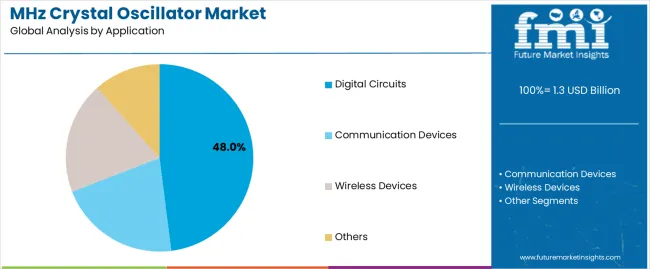
Market Context: Digital circuits applications dominate the market with approximately 48.0% market share due to widespread adoption of precision timing in microprocessors and increasing focus on clock synchronization, signal integrity, and performance management applications that minimize timing errors while maintaining electronics industry standards.
Appeal Factors: Electronics manufacturers prioritize oscillator reliability, frequency accuracy, and integration with existing semiconductor design infrastructure that enables coordinated timing application across multiple circuit platforms. The segment benefits from substantial electronics industry investment and performance optimization programs that emphasize the acquisition of stable oscillators for processor clocking and system synchronization applications.
Growth Drivers: Global semiconductor production expansion programs incorporate MHz crystal oscillators as standard timing components for processor operations, while advanced computing system development increases demand for high-precision oscillator capabilities that comply with clock distribution standards and minimize system latency.
Market Challenges: Varying semiconductor design standards and circuit complexity differences may limit oscillator standardization across different manufacturing facilities or operational scenarios.
Application dynamics include:
Communication devices applications capture approximately 30.0% market share through specialized timing requirements in network infrastructure manufacturing, base station production, and telecommunications equipment applications. These facilities demand robust oscillator systems capable of maintaining frequency accuracy while providing exceptional synchronization performance and network-grade stability capabilities. The segment experiences steady growth driven by expanding 5G infrastructure markets, increasing network densification requirements, and rising demand for carrier-grade timing that enhances network reliability and reduces synchronization errors in demanding telecommunications environments.
Wireless devices applications account for approximately 15.0% market share, while other segments capture 7.0%, including consumer electronics timing, industrial control systems, and specialty instrumentation applications requiring crystal oscillator capabilities for frequency generation and timing compliance. These segments demonstrate steady growth patterns supported by expanding IoT device deployments, increasing demand for wireless connectivity, and growing adoption of oscillator solutions in specialty electronics applications requiring enhanced timing verification and frequency stability.
Growth Accelerators: 5G infrastructure expansion drives primary adoption as MHz crystal oscillators provide superior timing precision capabilities that enable network operators to meet stringent synchronization standards without excessive power consumption, supporting communication operations and data transmission missions that require precise frequency stability applications. IoT device proliferation demand accelerates market expansion as electronics manufacturers seek effective timing systems that minimize frequency drift while maintaining operational effectiveness during device operation and network communication scenarios. Semiconductor industry activity increases worldwide, creating steady demand for precision oscillator systems that complement traditional clocking processes and provide performance differentiation in competitive electronics markets.
Growth Inhibitors: MEMS oscillator competition challenges vary across application segments regarding silicon-based timing alternatives and programmable solutions, which may limit market share and penetration in cost-sensitive consumer electronics or high-volume manufacturing operations. Technical performance limitations persist regarding temperature coefficient considerations and long-term aging concerns that may reduce effectiveness in extreme temperature conditions, harsh environmental scenarios, or extended operation periods, affecting frequency stability and accuracy requirements. Market fragmentation across multiple frequency standards and application-specific requirements creates compatibility concerns between different oscillator suppliers and existing circuit design infrastructure.
Market Evolution Patterns: Adoption accelerates in 5G infrastructure and high-performance computing sectors where timing precision justifies oscillator costs, with geographic concentration in developed markets transitioning toward mainstream adoption in emerging economies driven by network modernization and digital transformation. Technology development focuses on enhanced crystal processing, improved temperature compensation, and compatibility with advanced packaging systems that optimize frequency effectiveness and stability performance. The market could face disruption if MEMS oscillator technologies or atomic clock miniaturization significantly limit the deployment of quartz-based oscillators in timing applications, though crystal oscillators' unique combination of cost-effectiveness, proven reliability, and precise frequency control continues to make them preferred in mainstream electronic applications.
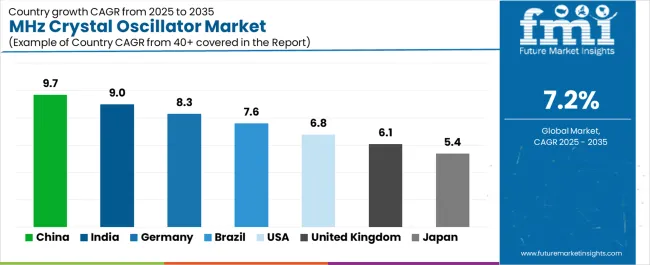
The market demonstrates varied regional dynamics with Growth Leaders including China (9.7% CAGR) and India (9.0% CAGR) driving expansion through 5G infrastructure capacity additions and electronics manufacturing programs. Steady Performers encompass Germany (8.3% CAGR), Brazil (7.6% CAGR), and United States (6.8% CAGR), benefiting from established telecommunications industries and advanced technology adoption. Mature Markets feature United Kingdom (6.1% CAGR) and Japan (5.4% CAGR), where specialized communication applications and precision electronics integration support consistent growth patterns.
| Country | CAGR (2025-2035) |
|---|---|
| China | 9.7% |
| India | 9.0% |
| Germany | 8.3% |
| Brazil | 7.6% |
| United States | 6.8% |
| United Kingdom | 6.1% |
| Japan | 5.4% |
Regional synthesis reveals Asia Pacific markets leading adoption through 5G infrastructure expansion and electronics manufacturing infrastructure development, while European countries maintain steady expansion supported by telecommunications technology advancement and industrial automation requirements. North American markets show moderate growth driven by data center applications and communication infrastructure integration trends.
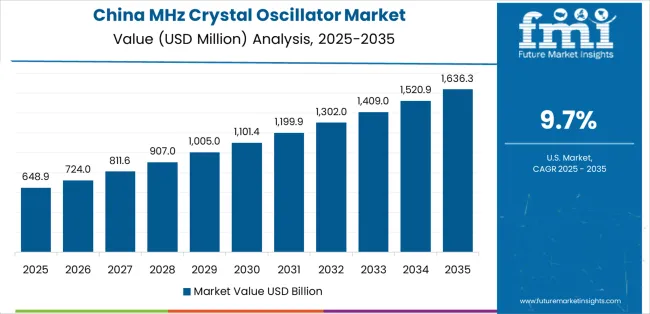
The Chinese market emphasizes advanced oscillator features, including precision frequency control and integration with comprehensive 5G infrastructure platforms that manage network synchronization, timing accuracy, and stability applications through unified monitoring systems. The country demonstrates strong growth at 9.7% CAGR, driven by 5G network deployment expansion, electronics manufacturing initiatives, and emerging IoT device development that support crystal oscillator integration. Chinese manufacturers prioritize operational effectiveness with MHz crystal oscillators delivering consistent timing through advanced frequency capabilities and production adaptation features.
Technology deployment channels include major telecommunications operators, specialized oscillator suppliers, and electronics industry procurement programs that support professional applications for complex network timing and device synchronization applications. Manufacturing platform integration capabilities with established communication systems expand market appeal across diverse operational requirements seeking frequency precision and stability benefits. The expanding 5G subscriber base and accelerating IoT device market create steady demand, while innovative applications in autonomous vehicles and smart city infrastructure open new growth avenues.
Performance Metrics:
Germany's advanced industrial market demonstrates sophisticated crystal oscillator deployment with documented operational effectiveness in automotive electronics applications and industrial equipment facilities through integration with existing quality systems and production infrastructure. The country leverages engineering expertise in precision timing and electronics systems integration to maintain strong growth at 8.3% CAGR. Industrial centers, including Munich, Stuttgart, and Dresden, showcase premium installations where oscillator systems integrate with comprehensive automotive platforms and industrial automation systems to optimize timing precision and production effectiveness.
German manufacturers prioritize system reliability and automotive-grade compliance in oscillator selection, creating demand for premium frequency systems with advanced features, including wide temperature range operation and automated quality integration. The market benefits from established automotive electronics infrastructure and willingness to invest in high-precision technologies that provide long-term reliability benefits and compliance with international automotive and industrial standards.
Market Intelligence Brief:
The U.S. market demonstrates sophisticated deployment across 5G infrastructure applications with documented effectiveness in network equipment manufacturing and data center facilities through integration with comprehensive timing management systems and quality assurance infrastructure. The country leverages advanced manufacturing capabilities in telecommunications innovation and precision electronics technology to maintain moderate growth at 6.8% CAGR. Industrial centers, including California, Texas, and Massachusetts, showcase premium installations where oscillator systems integrate with comprehensive network platforms and synchronization systems to optimize infrastructure positioning and timing effectiveness.
American manufacturers prioritize timing precision and network-grade reliability in oscillator development, creating demand for advanced frequency systems with specialized features, including ultra-low phase noise and synchronization capabilities. The market benefits from established telecommunications infrastructure and willingness to invest in precision technologies that provide long-term network benefits and compliance with carrier-grade timing standards.
Market Intelligence Brief:
The U.K. market demonstrates advanced telecommunications deployment with documented operational effectiveness in network infrastructure applications and communication equipment facilities through integration with existing synchronization systems and regulatory infrastructure. The country leverages telecommunications expertise in precision timing and network systems integration to maintain steady growth at 6.1% CAGR. Industrial centers, including London, Reading, and Cambridge, showcase professional installations where oscillator systems integrate with comprehensive network platforms and timing distribution systems to optimize synchronization compliance and frequency effectiveness.
British manufacturers prioritize system reliability and telecommunications compliance in oscillator development, creating demand for certified frequency systems with advanced features, including stratum-level accuracy and network synchronization integration. The market benefits from established telecommunications infrastructure and commitment to invest in precision technologies that provide long-term network benefits and alignment with UK and international telecommunications timing standards. 5G network applications, industrial IoT systems, and smart infrastructure programs drive diversified demand across multiple end-use segments.
Strategic Market Indicators:
India's market demonstrates rapid expansion deployment with documented operational effectiveness in 5G infrastructure applications and electronics manufacturing facilities through integration with emerging network systems and production development infrastructure. The country leverages growing industrial capabilities in electronics manufacturing and telecommunications systems integration to achieve high growth at 9.0% CAGR. Industrial centers, including Bangalore, Hyderabad, and Chennai, showcase expanding installations where oscillator systems integrate with comprehensive telecommunications platforms and manufacturing networks to optimize network deployment and production effectiveness.
Indian manufacturers prioritize cost-effectiveness and international timing standards in oscillator development, creating demand for reliable frequency systems with competitive features, including automated testing integration and quality verification systems. The market benefits from expanding 5G infrastructure deployment and willingness to invest in precision technologies that provide competitive differentiation and compliance with global telecommunications standards.
Market Intelligence Brief:
Brazil's market demonstrates expanding deployment with documented operational effectiveness in telecommunications infrastructure applications and electronics manufacturing facilities through integration with developing network systems and quality infrastructure. The country leverages growing industrial capabilities in telecommunications services and electronics systems integration to maintain solid growth at 7.6% CAGR. Industrial centers, including São Paulo, Rio de Janeiro, and Brasília, showcase growing installations where oscillator systems integrate with comprehensive telecommunications platforms and network infrastructure to optimize connectivity and timing effectiveness.
Brazilian manufacturers prioritize network integration and telecommunications compliance in oscillator development, creating demand for certified frequency systems with advanced features, including temperature-compensated designs and network synchronization systems. The market benefits from expanding telecommunications infrastructure and commitment to invest in timing technologies that provide network advantages and alignment with international telecommunications standards.
Strategic Market Indicators:
Japan's market demonstrates precision deployment with documented operational effectiveness in ultra-premium consumer electronics applications and specialized telecommunications facilities through integration with advanced manufacturing systems and quality control infrastructure. The country leverages engineering excellence in precision crystal manufacturing and electronics systems integration to maintain steady growth at 5.4% CAGR. Industrial centers, including Tokyo, Osaka, and Kyoto, showcase premium installations where oscillator systems integrate with comprehensive quality platforms and electronics design systems to optimize frequency excellence and manufacturing effectiveness.
Japanese manufacturers prioritize system precision and frequency excellence in oscillator development, creating demand for ultra-premium timing systems with advanced features, including atomic-level frequency accuracy capabilities and integrated quality verification systems. The market benefits from established electronics infrastructure and commitment to invest in highest-precision oscillator technologies that provide superior timing positioning and adherence to stringent Japanese quality standards.
Strategic Market Indicators:

The MHz Crystal Oscillator market in Europe is projected to grow from USD 342.8 million in 2025 to USD 598.5 million by 2035, registering a CAGR of 5.7% over the forecast period. Germany is expected to maintain its leadership position with a 36.4% market share in 2025, declining slightly to 35.8% by 2035, supported by its advanced automotive electronics infrastructure and major manufacturing centers in Munich, Stuttgart, and Dresden. France follows with a 20.6% share in 2025, projected to reach 21.1% by 2035, driven by comprehensive telecommunications programs and electronics manufacturing initiatives centered around Paris and Grenoble. The United Kingdom holds a 17.2% share in 2025, expected to stabilize at 17.0% by 2035 through specialized telecommunications activities, 5G infrastructure applications, and network equipment manufacturing in London, Reading, and Cambridge. Italy commands a 11.8% share in 2025, while Spain accounts for 8.4% aided by telecommunications infrastructure expansion and electronics production adoption in Madrid and Barcelona. The Netherlands maintains 3.2% share driven by specialty semiconductor applications and telecommunications equipment demand. The Rest of Europe region is anticipated to grow its collective share from 2.4% to 3.1% by 2035, reflecting consistent growth in Nordic countries, 5G infrastructure expansion in Central European markets, and telecommunications timing upgrades across Eastern European network facilities.
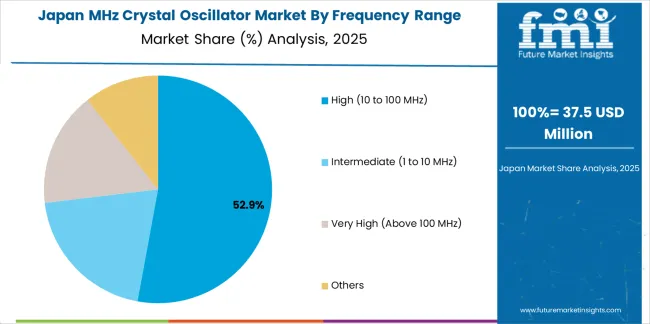
In Japan, the MHz Crystal Oscillator market prioritizes high-frequency (10 to 100 MHz) oscillator systems, which capture approximately 58.0% market share of consumer electronics and telecommunications installations due to their advanced features, including precision frequency characteristics and seamless integration with existing microprocessor infrastructure. Japanese manufacturers emphasize reliability, precision, and long-term frequency stability, creating demand for high-frequency oscillator systems that provide consistent timing capabilities and superior phase noise performance based on electronics requirements and quality standards. Intermediate frequency oscillators maintain secondary positions with approximately 28.0% share primarily in embedded systems applications and IoT device installations where comprehensive timing functionality meets operational requirements without high-frequency specifications.
Market Characteristics:
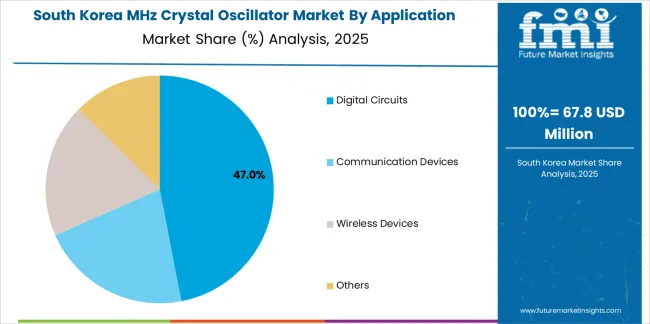
In South Korea, the market structure favors international oscillator manufacturers, including SiTime, Microchip, and Epson, which maintain dominant positions with approximately 56.0% combined market share through comprehensive product portfolios and established electronics industry networks supporting both consumer device and telecommunications applications. These providers offer integrated solutions combining advanced crystal oscillator systems with professional technical services and ongoing engineering support that appeal to Korean electronics manufacturers seeking reliable precision timing systems. Local oscillator contractors and specialty suppliers capture approximately 30.0% market share by providing localized service capabilities and competitive pricing for standard timing applications, while domestic manufacturers focus on specialized IoT devices and cost-effective solutions tailored to Korean electronics market characteristics with the remaining 14.0% share.
Channel Insights:
The market operates with moderate concentration, featuring approximately 20-25 meaningful participants, where leading companies control roughly 52-57% of the global market share through established electronics relationships and comprehensive oscillator product portfolios. Competition emphasizes advanced frequency capabilities, stability reliability, and manufacturer integration rather than price-based rivalry. The leading companies, including SiTime and Microchip, command approximately 32.0% combined market share through their extensive oscillator product lines and global electronics industry presence.
Market Leaders encompass SiTime, Microchip, KDS, and Kyocera, which maintain competitive advantages through extensive frequency control expertise, global electronics networks, and comprehensive timing integration capabilities that create customer loyalty and support premium pricing. These companies leverage decades of crystal oscillator technology experience and ongoing material investments to develop advanced MHz oscillator systems with precision frequency control and temperature stability features. SiTime holds approximately 18.0% market share through specialized MEMS oscillator expertise, while Microchip captures approximately 14.0% share focusing on integrated timing solutions.
Technology Innovators include Epson, TXC, Murata, Renesas, NDK, and specialized manufacturers like Siward Crystal Technology, CTS Corporation, Rakon, and Taitien, which compete through specialized crystal formulation focus and innovative frequency capabilities that appeal to manufacturers seeking advanced timing solutions and application differentiation. These companies differentiate through rapid product development cycles and specialized telecommunications and automotive application focus, collectively capturing approximately 25-30% market share. Regional Specialists feature oscillator manufacturers focusing on specific geographic markets and specialized applications, including ultra-stable timing systems and integrated frequency control solutions.
Market dynamics favor participants that combine reliable crystal formulations with advanced frequency capabilities, including precision temperature compensation and automated quality optimization features. Competitive pressure intensifies as MEMS oscillator suppliers expand into crystal frequency ranges, while telecommunications equipment manufacturers challenge established players through innovative timing solutions and network-synchronized platforms targeting 5G infrastructure and IoT device segments. Strategic differentiation increasingly centers on comprehensive technical partnership capabilities, rapid customization services, and integrated timing certification documentation that address evolving telecommunications requirements and electronics performance standards.
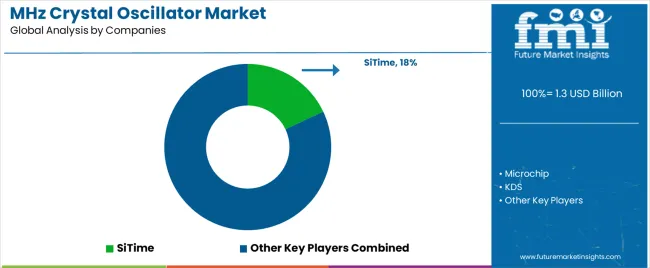
| Item | Value |
|---|---|
| Quantitative Units | USD 1.3 billion |
| Frequency Range | Intermediate (1 to 10 MHz), High (10 to 100 MHz), Very High (Above 100 MHz), Others |
| Application | Digital Circuits, Communication Devices, Wireless Devices, Others |
| Regions Covered | Asia Pacific, Europe, North America, Latin America, Middle East & Africa |
| Countries Covered | China, India, Germany, Brazil, United States, United Kingdom, Japan, and 20+ additional countries |
| Key Companies Profiled | SiTime, Microchip, KDS, Kyocera, Epson, TXC, Murata, Renesas, NDK, Siward Crystal Technology, CTS Corporation, Rakon, Taitien |
| Additional Attributes | Dollar sales by frequency range and application categories, regional adoption trends across Asia Pacific, Europe, and North America, competitive landscape with crystal oscillator manufacturers and electronics suppliers, manufacturer preferences for frequency stability and timing precision, integration with semiconductor platforms and network synchronization monitoring systems, innovations in crystal processing formulations and temperature compensation excellence, and development of automated testing solutions with enhanced performance and manufacturing optimization capabilities. |
The global MHz crystal oscillator market is estimated to be valued at USD 1.3 billion in 2025.
The market size for the MHz crystal oscillator market is projected to reach USD 2.6 billion by 2035.
The MHz crystal oscillator market is expected to grow at a 7.2% CAGR between 2025 and 2035.
The key product types in MHz crystal oscillator market are high (10 to 100 mhz), intermediate (1 to 10 mhz), very high (above 100 mhz) and others.
In terms of application, digital circuits segment to command 48.0% share in the MHz crystal oscillator market in 2025.






Full Research Suite comprises of:
Market outlook & trends analysis
Interviews & case studies
Strategic recommendations
Vendor profiles & capabilities analysis
5-year forecasts
8 regions and 60+ country-level data splits
Market segment data splits
12 months of continuous data updates
DELIVERED AS:
PDF EXCEL ONLINE
433MHz Active RFID Reader Market Size and Share Forecast Outlook 2025 to 2035
Crystal Malt Market Size and Share Forecast Outlook 2025 to 2035
Crystallization Equipment Market Size and Share Forecast Outlook 2025 to 2035
Crystal Products Market Size and Share Forecast Outlook 2025 to 2035
Crystal Barware Market Size and Share Forecast Outlook 2025 to 2035
Crystalline Fructose Market Growth - Trends & Forecast through 2034
Crystal Oscillator Market Analysis - Size, Share, and Forecast 2025 to 2035
Nanocrystalline cellulose Market Size and Share Forecast Outlook 2025 to 2035
Monocrystalline Solar Cell Market Size and Share Forecast Outlook 2025 to 2035
Nanocrystal Packaging Coating Market Analysis - Size, Share, and Forecast 2025 to 2035
Polycrystalline Silicon Market Growth 2025 to 2035
Microcrystalline Cellulose Market Size and Share Forecast Outlook 2025 to 2035
Anti Crystallizing Agents Market
Microcrystalline Wax Market
Liquid Crystal Polymers Market Size and Share Forecast Outlook 2025 to 2035
Liquid Crystal Polymer (LCP) Market Size and Share Forecast Outlook 2025 to 2035
Protein Crystallization and Crystallography Market Analysis - Growth & Forecast 2025 to 2035
Photonic Crystal Displays Market Size and Share Forecast Outlook 2025 to 2035
Industrial Crystallizer Market Size and Share Forecast Outlook 2025 to 2035
Cellulose Nanocrystals and Nanofibers Market Size and Share Forecast Outlook 2025 to 2035

Thank you!
You will receive an email from our Business Development Manager. Please be sure to check your SPAM/JUNK folder too.
Chat With
MaRIA